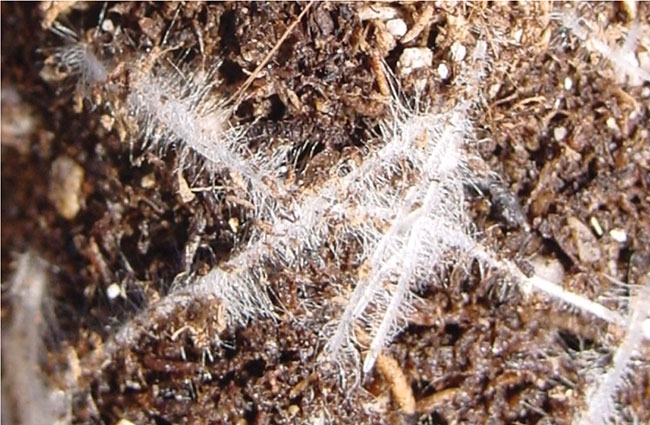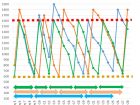
Features
Structures & Equipment
Water and irrigation
How to effectively water by weight
Are your plants being watered too much? Watering by weight could remove the subjectivity from this time-consuming process.
April 1, 2019 By Interview with Dr. Will Healy Ball Horticultural Company
 Branched roots have more surface area.
Branched roots have more surface area. How wet is ‘wet’, and how dry is ‘dry’?
At the Green Industry Show in Edmonton last year, Dr. Will Healy, senior technical and research manager at Ball Horticultural Company, spoke about a method to describe soil wetness using Levels 1 through 5:
- Level 1, Dry: dry, tan to white, crumbles to dust, shrinks from container walls
- Level 2, Medium Dry: light brown, no free water, squeaky soil, crumbles apart
- Level 3, Medium: brown, hard to squeeze water, soil cracks apart
- Level 4, Medium Wet: dark brown, no visible water, easily squeeze water, soil sticks together
- Level 5, Wet: black, free water, saturated, similar to pudding or tofu
The grower then creates and weighs each level (tray + soil + water) to objectively ensure that plants don’t get too much, or too little, water. This is called watering by weight. Following his talk, Healy shared additional pointers on this influential method with Greenhouse Canada:
1. Look at the top and bottom of the container
Avoid a Level 1 in the bottom since roots will not grow into soil that is maintained at that dry level – the soil becomes “salty” when fertilized and concentrates as it dries.
When the bottom is maintained at a Level 5, a perched water table forms, which then keeps the bottom portion of the container saturated. If it persists for more than several hours, water roots (smooth, non-branched roots) can develop, which result in limited nutrient uptake due to limited root surface for absorption, compared to a branched root that forms when the bottom is allowed to dry to a Level 2.
Look carefully at the moisture level in the top third of the container. If you keep the top consistently at a Level 4-5 and the bottom at a Level 2, then water roots will form horizontally in this wetter area. Growers who frequently water “a little bit” and don’t push water to the bottom of the container end up creating the 4-5 top and 2-3 bottom scenario, which is the opposite of what you want (2-3 top and 4 bottom).
2. Don’t overthink it
We water too frequently, which keeps the soil at a constant Level 4-5. I have worked with growers who simply water when the top approaches a Level 2 and the bottom begins to reach a Level 2-3. The only exception to the strategy of maintaining a Level 4-2 is seed germination. (In a limited number of situations, like Begonia or Petunia, a 4-3 may produce better germination and yields.)
A large, actively growing plant will absorb more water from the soil moisture than a small or slowly growing plant. Wait until the plants reach the critical dry targets and apply sufficient water to reach the wet target instead of randomly watering on a time or convenience schedule. If you maintain the 4-2 targets, then the environment and plant will drive the water removal from the soil.
3. Water by weight
The challenge growers face is not what one plant is doing, but how to execute this strategy over a wide range of pots in a large production block. This is why we went to water by weight (WbW) since it allows us to quickly assess the weight of a container and determine if we are approaching a point where the entire block is ready for an irrigation (dry target) and if enough water was applied (wet target). What WbW does is it puts a number (weight) to when the crop is dry or wet. Weight is the weight of the entire container (top to bottom, cell to cell in trays). Growers still need to see if the bottom of the container is dry or wet to ensure they are watering correctly, i.e. pushing the water to the bottom of the container when they water.
Growers will sample three to five plants in a block to determine what the average weight is between the sampled containers. What if variability between containers is more than 100 g? This means that the previous irrigation was not applied uniformly to all the containers or that some containers are drying out faster.
If you have excess airflow or hot spots in the bench, those containers will dry more rapidly than the containers around them. Apply more water (weight) to drier areas so when you are done irrigating, you have about the same container weight in the hot and breezy areas as you do in the middle of the block .
Should the containers all be the same weight? No; that is working too hard. If you can keep the containers in a block within 100 g of the target weights, this is close enough! It is very difficult to have all the containers the same.
4. Avoid watering late in the afternoon
Watering late in the day runs the risk of watering to a Level 5, which creates a perched water table and water roots. Plant cells are like water balloons: When there is a lot of free water, the cells take up more water and the stem stretches. Stem stretch occurs during the night so if there is a lot of free water in the container at night, the plant cells can easily stretch.
Late-day watering also results in elevated relative humidity around the plants, creating the perfect environment for disease.
It is easier to manage watering times when you use WbW targets. Growers can determine if there is enough water in the container to survive until the next morning or add only enough water to raise the moisture level to a Level 4 or less.
5. The times between dry targets matter
“Fish grow in water and ROOTS grow in air.” A strong root system is critical for optimum growth and extended post-harvest. Over the last few years, we have done extensive trials to determine how to optimize root development. What we know is, the time between dry targets is directly related to the number of branched roots in a container. The longer the duration between dry targets, the fewer branched roots you observe, and the more water roots you see.
The graph above shows three different irrigation strategies that growers used. The dry target was 600 g and the wet target was 1600 g. They failed to hit the dry and wet targets in the orange and blue curves. Bottom arrows show the number of days between irrigations. By staying within the wet-dry targets, the “green” grower irrigated his crop five times while the “orange” grower irrigated four. The “blue” grower is considered a wet grower – irrigating only three times due to exceeding the wet target and failing to hit the dry target.
When growers fail to reach a Level 4 wet target, the soil is too dry and roots don’t develop. This is why it is important to irrigate to the wet target and allow the plants to reach the dry target.
6. Let the environment help
We train growers all wrong! We train them to “water thoroughly” when in reality they need to know how to “dry the plant to the dry target.” Environment plays a huge role in drying out the crop. Remember the plant uses less than 10 per cent of the water to grow, the rest must be evaporated to prevent soft, stretched plants and diseases. It is a challenge that can be solved by dehumidification strategies.
Hot air contains more water than dry air. Periodically heat up the greenhouse a couple of degrees and then slowly vent the warm-wet air out. If you vent too fast, you will never remove the maximum amount of humidity. If you don’t have top vents, move the air in the greenhouse and vent some of the wet air to help reduce humidity and help dry out the crop.
7. Water from top to bottom
When we water from top to bottom, we make sure we are driving the roots to the bottom of the container. Thorough watering, which means you achieve one drip – not a river of water – out of the bottom of the container, is critical to preventing the development of a perched water table. Now, there are times when high salts accumulate in the soil where a heavy drip is needed.
When we have a strong root system in the bottom of the container, we have a plant that will perform for both the retailer and the consumer. When we have a poorly rooted plant, the plant will not perform for either.
8. It is never too late (Well, on the dock at shipping it is!)
Plants are resilient in adapting to our watering practices. If you have a crop that is clearly not being irrigated to your wet-dry targets, the quicker you can achieve the right balance of wet-dry, the faster you can turn the crop around. This is why we recommend growers record the weight when they water (dry weight) and immediately after irrigating (wet weight).
Too many times we see the crop has gone “off the rails,” and when questioned, the grower says they did everything “right.” By graphing the wet-dry weights, you can understand what you did days or weeks earlier and begin remedial strategies to turn the crop around. Create a teachable moment!
For more watering tips from Healy, listen to the STEM Greenhouse Podcast from Ball Seed – Episodes 21 and 22: “The Language of Watering” (https://www.podbean.com/media/share/pb-c7qv8-a0a1fb) and “Watering: The Rest of the Story” (https://www.podbean.com/media/share/pb-deqxd-a1c93e). Subscribe to STEM: Insider Tips for Greenhouse Pros on any podcast player.
Print this page


